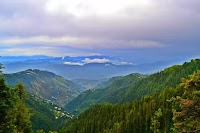The fort was built between 1785 to 1795 by Mir Sohrab Khan Talpur, founder of the Kingdom of Upper Sindh in 1783. In addition to the fort, a 5 kilometer, 12 feet wide mud wall was built around the city. This defensive wall had bastions throughout its length and a huge iron gate served as the city's only entrance.
The people of the Kot Diji lived about 3,000 BCE. The Kot Diji excavated by the Pakistan Department of Archaeology in 1955 and 1957 has found lot of stuffs showing the evidence that lot of stuffs were borrowed from Kot Diji to Indus Civilization cities.
The fort is over half a kilometer long. Its walls are segmented by about 50 bastions, and its 1.8 km outer perimeter wall identically follows the double crescent-shaped contours of the hill it stands on. This allows the fort to surround the attacking enemy on three sides on the west front. On the east, where the entrance lies, the fort is divided by three elephant-proof gates into three overlapping levels, so that the first two levels can be attacked by the next level above them in the event of the lower level being overrun by the enemy. The first gate is not a prominent portal but rather an indirect entry so that the gate cannot be rammed on a charge. The walls and bastions have arrow slits in them, allowing defenders to attack their enemy from two levels: from the battlement on top and from within the wall.
The fort was built at a time when cannons had become common and its design and position reveals that. It includes a multitude of stations for cannons and,because it is positioned high on a narrow ridge, enemy cannons would have had to fire at a great distance, permitting little accuracy. Cannonballs could either hit the hill or perimeter or would simply fly over the fort and fall on the enemies' own forces on the other side.
The tomb of Fakir Qadir Bakhsh, after whom this site is named, lies to the west of the village of the same name. Inside the tomb there are two graves, one obviously being that of Fakir Qadir Bakhsh, of whom little is known, but nothing is known about the other; it is presumed to be that of a disciple, the Fakir never having married. The tomb of Golo Shahani, the commander-in-chief of the army of Mir Suhrab Khan, is also situated here, as well as a number of other graves of the Shahanis. Golo Shahani died in battle at Shikarpur in AH 1249 (AD 1833). On the eastern side of the tomb of Fakir Qadir is the tomb of Syed Saleh Shah, of whom nothing is known, and to the west of it, a mosque which is said to have been constructed by Fakir Qadir Bakhsh himself. The village has a population of approximately 500 individuals, who live in fifty houses



